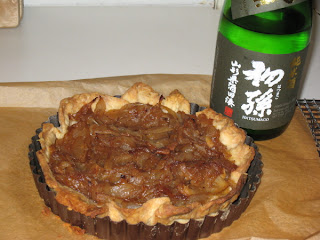
It has been long time since we've updated our blog....but we have a very good reason. We've been a bit preoccupied with the launch of our store, SAKAYA, NYC's first sake-centric shop which opened December 8. The reception has been phenomenal and we've been extremely fortunate that New Yorkers have so enthusiastically embraced it.
After a busy Christmas Eve, we were grateful to have Christmas Day off to relax and cook at home. Although we were not in the store, Hiroko was still thinking about new ideas for pairing sake with food. We would like to share her one of her inspirations, a carmelized onion tart which paired perfectly with Hatsumago Kimoto Junmai.
Carmelized Onion Tart
in 8 inch tart pan
2 onions
1 tablespoon of butter or olive oil
1/2 cup Madeira
1/2 cup shredded Gruyere
salt and pepper
Pie Dough for 8-inch tart pan
1 cup flour
5 tablespoons butter
3 to 5 tablespoons ice cold water
salt
Make the Dough:
1. Cut the butter into cubes. Wrap in plastic and freeze. In the large bowl, sift the flour, and combine the flour and salt. Put the flour mixture into a freezer to chill.
2. Dump the cold butter into the cold flour, and cut the butter using pastry cutter.
3. When the mixture gets coarse like oat meal, sprinkle the ice cold water 1 tablespoon at a time to incorporate the mixture, using fork or hand. As the dough begins to form clumps, you need to test it. If you can gather it up to form a ball, it is ready.
4. Gather the mixture into one ball, and wrap it in plastic wrap to chill for at least 1 hour.
Assembly:
1. In a large skillet, met the butter or oil. Add the onions, and cook over moderate heat until softened about 10 to 15 minutes. Uncover the skillet and cook until the onions are very soft and browned about 45 minutes or longer. While the onion is caramelizing, add the 1/4 cup of Madeira. When the onion is caramelized, add the rest of Madeira and cook until the liquid is evaporated. Season with salt and pepper.
2. Preheat the oven to 425 degrees. Roll out the dough and place it in a tart pan. Prick the bottom of the shell with a fork and freeze it until chilled.
3. Line the tart shell with foil and fill with dried kidney beans (or pie crust weights). Bake in the oven for 15 minutes, and remove the foil and beans and bake it another 10 to 15 minutes, until the shell is golden color.
4. Sprinkle the Gruyere into the baked tart shell and spread the onions on the top. Bake for 10 to 15 minutes, until the cheese is melted and the tart is browned. Let cool for 15 minutes.














































